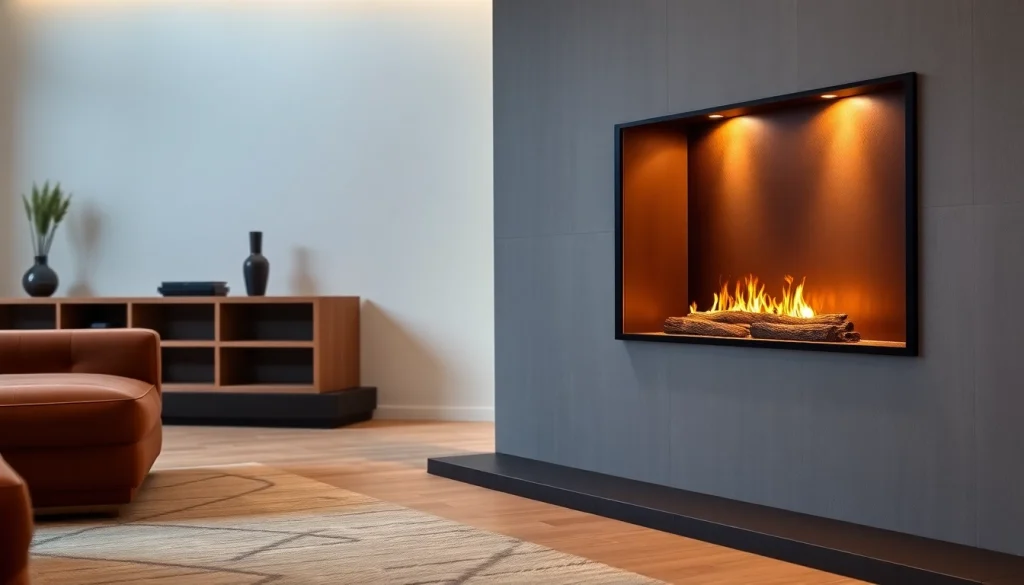Understanding Automatic Bioethanol Fireplaces
An automatic bioethanol fireplace represents the pinnacle of modern home heating solutions, marrying innovative technology with aesthetic appeal. Unlike traditional wood-burning or gas-fueled fireplaces, these units utilize bioethanol, a renewable and environmentally friendly fuel source derived from plants. Automatic models offer unparalleled convenience and functionality, making it easier than ever to enjoy the cozy warmth and ambiance of a fireplace without the hassle of logs, ash, or extensive installation protocols.
What is an Automatic Bioethanol Fireplace?
At its core, an automatic bioethanol fireplace is a heating appliance that burns bioethanol fuel and incorporates state-of-the-art technology for remote operation and automation. These units are designed to ignite spontaneously at the push of a button, allowing users to enjoy a flickering flame with little effort. Most modern variations come equipped with features such as flame height adjustment, safety sensors, and sometimes even smart home compatibility, allowing for seamless integration with systems like Amazon Alexa or Google Home.
Key Features to Look For
- Remote Control: The ability to control the fireplace with a remote or via an app enhances convenience and user experience.
- Flame Adjustment Settings: Some models allow users to adjust the size and intensity of the flame, catering to personal preferences and space requirements.
- Safety Features: Look for models with built-in safety sensors that automatically shut off the fireplace in case of accidents, like overheating or fuel depletion.
- Easy Refueling: Models that facilitate straightforward refueling processes can help avoid user frustrations during maintenance.
- Design Versatility: The aesthetic appeal can’t be overlooked; choose a design that complements your home’s interior style.
Benefits Over Traditional Fireplaces
Automatic bioethanol fireplaces offer several advantages compared to more traditional heating sources:
- No Chimney Required: Unlike wood-burning stoves that necessitate venting and chimney installation, bioethanol fireplaces need no such infrastructure, allowing for greater placement flexibility within your home.
- Environmentally Friendly: Bioethanol is a clean-burning fuel that produces minimal emissions, making it a sustainable choice over conventional fossil fuels.
- Low Maintenance: The operation and upkeep of an automatic bioethanol fireplace demands less effort than traditional alternatives, eliminating the constant need for cleaning ash or soot.
- Quick Installation: With their plug-and-play nature, most units can be set up without professional assistance, saving both time and installation costs.
- Aesthetic Appeal: Many models feature modern designs that contribute to home decor, enhancing overall ambiance and comfort levels.
Choosing the Right Model for Your Home
Selecting the proper automatic bioethanol fireplace involves assessing several key factors that align with your preferences and home environment.
Top Brands and What They Offer
When considering brands, it’s essential to focus on those known for quality, reliability, and customer support. Some reputable brands in the field include:
- Ignis Products: Offers a range of smart bio-ethanol burners equipped with advanced features such as remote control and Alexa compatibility.
- AFIRE: Provides high-quality automatic bioethanol fireplaces, renowned for their innovative technology and elegant designs.
- Planika: Known for its premium designs, Planika integrates cutting-edge technology into their fireplaces, including safety systems and intelligent controls.
- The Bio Flame: Specializes in aesthetically pleasing models that blend luxury with functionality, offering a variety of styles to suit individual tastes.
Size and Design Considerations
The size and design of your fireplace should complement your room. Here are some considerations to keep in mind:
- Room Size: Larger rooms may require more significant models or multiple units to effectively distribute heat, while smaller spaces might need compact designs.
- Style Integration: Choose a model that aligns with your interior design theme—modern, rustic, or traditional—to maintain a cohesive atmosphere.
- Placement: Consider where your fireplace will be placed. Wall-mounted options can save space while freestanding models can serve as a central feature in a room.
Preparing Your Space for Installation
Before installing your automatic bioethanol fireplace, ensure that your selected space is adequately prepared:
- Clear Space: Remove any clutter from the area where the fireplace will be installed to ensure safety and accessibility.
- Check for Power Sources: Ensure there are nearby power outlets for units that require electrical power and have easy access for plugging in.
- Ventilation: Although automatic bioethanol fireplaces produce minimal emissions, a well-ventilated area enhances air quality and comfort.
Installation and Maintenance Tips
Proper installation and maintenance are crucial for ensuring the longevity and performance of your fireplace.
Step-by-Step Installation Guide
While installation might differ between models, here’s a general step-by-step guide:
- Unpack the Unit: Carefully open the package and ensure all parts are accounted for according to the manual.
- Identify the Installation Location: Choose a flat surface that adheres to your previously determined placement plan.
- Install Components: Follow the manufacturer’s instructions to connect required components, including any fueling mechanisms.
- Plug In: If applicable, connect the fireplace to a power source.
- Test the Unit: Before regular use, run a test to ensure that the unit operates as specified.
Regular Maintenance Practices
To keep your automatic bioethanol fireplace functioning optimally, consider the following maintenance tips:
- Clean Glass Panels: Use appropriate cleaners to ensure the glass remains clear for optimal viewing of the flames.
- Inspect Fuel Reservoir: Regularly check the bioethanol reservoir for any leaks or damage.
- Filter Changes: Some models may have filters that need periodic replacement, so be sure to follow the manufacturer’s recommendations.
Troubleshooting Common Issues
Here are solutions to some frequent issues that users might face:
- Flame Failing to Ignite: Ensure there’s sufficient fuel and that the power source is connected. If problems persist, consult the troubleshooting section of the manual.
- Uneven Flames: This may indicate a need for fuel replacement or ventilation issues. Examine the unit for blockages or refuel as needed.
- Excessive Smell: If you notice an odour, check the fuel type to ensure it is appropriate bioethanol fuel and refuel as much as necessary.
Cost and Considerations
Understanding the costs associated with an automatic bioethanol fireplace can help in budgeting and future planning.
Price Ranges for Automatic Bioethanol Fireplaces
Prices vary based on brand, model, and features. Generally, consumers can expect the following price ranges:
- Basic Models: $500 – $1,000.
- Mid-Range Models: $1,000 – $2,500.
- High-End Models: $2,500 and up.
Operational Costs: Fuel and Maintenance
Operational costs will include ongoing expenses for bioethanol fuel and potential maintenance. On average, bioethanol can cost between $1 and $3 per hour of continuous use, depending on the designated flame size. Regular maintenance practices can incur minor costs, primarily for cleaning supplies or replacement parts.
Comparing Automatic vs. Manual Models
When deciding between automatic and manual bioethanol fireplaces, various factors should influence your choice:
- Convenience: Automatic models offer a significant edge with remote control capabilities, reducing the physical effort needed to start and manage the fire.
- Safety Features: Automatic units typically have advanced flame and fuel management systems that improve safety compared to manual counterparts.
- Cost Differences: While manual units are often less expensive, the trade-off for the ease of use and advanced features of automatic units may justify the price gap for many consumers.
Enhancing Home Decor with a Fireplace
Beyond their functional benefits, automatic bioethanol fireplaces can significantly enhance home decor.
Design Ideas to Showcase Your Fireplace
Positioning your fireplace as a focal point can elevate the overall design of your room. Consider these ideas:
- Feature Wall: Consider installing your fireplace on a feature wall to draw attention. Use complementary shades and materials to integrate it seamlessly into the room.
- Surrounding Decor: Use mantels, shelving, or display pieces that align with the fireplace’s design to create an engaging visual narrative.
- Layered Lighting: Accentuate the ambiance with layered lighting—incorporating dimmable wall lights or accent spotlights can enhance the beauty of the flames.
Creating a Cozy Atmosphere
Utilizing your fireplace as part of your overall atmosphere can turn your living spaces into cozy retreats:
- Plush Textiles: Use soft throws, rugs, and pillows to create an inviting seating area around the fireplace.
- Nature Elements: Incorporate natural materials such as wood or stone in close proximity to the fireplace to foster warmth and connection to nature.
- Color Palette: Consider warm colors like reds, yellows, and browns that can evoke the warmth of a natural flame, helping to unify your space.
Incorporating Modern Technology
As technology evolves, so do our fireplaces. Embracing smart home technology can significantly enhance the usability of your automatic bioethanol fireplace:
- Smart Home Integration: Enable voice controls or app-based adjustments for temperature and ambiance settings that align with your daily routines.
- Automation and Scheduling: Some models offer scheduling features, allowing you to automate flame settings based on the time of day.
- Energy Monitoring: Certain advanced models track fuel consumption and provide data for smarter usage over time.


